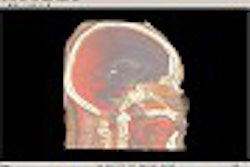Power Doppler (PD) imaging can be a valuable tool for the evaluation of ingestive and respiratory functions in the developing fetus, according to research published in the Journal of Ultrasound in Medicine.
Color Doppler (CD) ultrasound can have limitations in detecting amniotic fluid flow and discriminating between respiratory and ingestive fetal activity. To evaluate power Doppler imaging as a potential alternative, researchers from the Uniformed Services University and National Institutes of Health in Bethesda, MD, performed PD imaging during evaluations of the upper aerodigestive tract in 66 fetuses with a mean gestational age (GA) of 24 weeks (JUM, August 2002, Vol. 21:8, pp. 869-878).
In the study, an HDI 5000 ultrasound scanner (Philips Medical Systems, Andover, MA) was paired with a selection of broadband convex (C5-2 and C7-4) transducers. The researchers hoped to collect data on fetal aerodigestive patterns such as oral-nasal respiration, swallowing, and movements of the lips, jaw, tongue, pharynx, and larynx. Using specific bony and soft-tissue fiducial markers as anatomical landmarks, the examination included four image planes for viewing of the fetal face, oral cavity, pharynx, and larynx.
Compared with existing methods, PD demonstrated low-velocity, low-flow movement of amniotic fluid with greater sensitivity than color Doppler (CD), the researchers concluded.
"Our longitudinal experience with 66 subjects showed that a directed evaluation of the fetal upper aerodigestive tract with power Doppler imaging provided a systematic approach for studying the physiologic development of this region in both healthy and at-risk fetuses," they wrote.
To enhance low-flow detection, CD required adjustment to sensitivity and wall filtering. However, this produced an unacceptable degree of washout, a result consistent with reports in the general sonographic literature, the authors noted.
Low-velocity laminar flow on PD imaging yielded a relatively smooth column of color, allowing topographical details such as eddy currents to be visualized in high-flow activities or when the jets moved through nonuniform conduits such as the glottis.
"The effect of PD imaging was particularly apparent when observing amniotic flow jets produced during inhalation, exhalation, and pharyngeal swallowing," the group wrote.
PD imaging does have some drawbacks. As with other ultrasound methods, PD is limited by the depth and attenuation of intervening objects; as a result, fetal position may prevent completion of the entire four-part examination, the authors said. In addition, the technique was characterized by a steep learning curve for sonographers and image analysts.
However, PD techniques confirmed well-defined landmarks of the fetal upper aerodigestive tract, and can obtain reproducible imaging planes for evaluation of behavioral patterns, the group concluded. The relaxed, fluid-filled structures of the fetal pharynx, trachea, and oral cavity allowed for visualization of head and neck structures, they wrote.
"The definition of these anatomic landmarks and the high-resolution capabilities of today's PD technologies provide a more convenient way to evaluate respiratory, deglutitive, and related movement patterns in the developing fetus," the authors stated. "Our cohort of fetuses had a rich repertoire of oral and pharyngeal activities that in all likelihood might have been missed without the additional overlay of PD sonography. Thus, we consider the augmentation of imaging by PD sonography an essential tool in the four-part evaluation of developing aerodigestive behaviors."
By Erik L. RidleyAuntMinnie.com staff writer
October 9, 2002
Related Reading
Turf Wars in Radiology IV: Radiologists, ob/gyns sound off on fetal imaging, September 26, 2002
Birth weight prediction equation beats ultrasound for accuracy, September 26, 2002
US results in placental abruption can lead to overly aggressive management, September 10, 2002
Tissue velocity imaging shows promise in detecting fetal arrhythmias, September 10, 2002
Lean umbilical cord by ultrasound may predict early-onset preeclampsia, August 15, 2002
Copyright © 2002 AuntMinnie.com




















